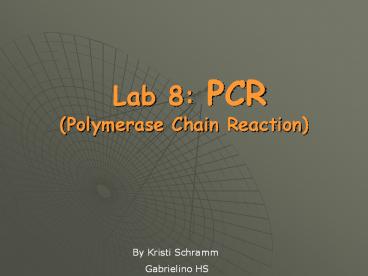Lab 8: PCR (Polymerase Chain Reaction) - PowerPoint PPT Presentation
1 / 19
Title:
Lab 8: PCR (Polymerase Chain Reaction)
Description:
Lab 8: PCR (Polymerase Chain Reaction) By Kristi Schramm Gabrielino HS PCR Polymerase Chain Reaction has many applications PCR is commonly used to produce many ... – PowerPoint PPT presentation
Number of Views:576
Avg rating:3.0/5.0
Title: Lab 8: PCR (Polymerase Chain Reaction)
1
Lab 8 PCR(Polymerase Chain Reaction)
By Kristi Schramm Gabrielino HS
2
PCR Polymerase Chain Reaction has many
applications
- PCR is commonly used to produce many copies of a
selected gene segment or locus of DNA. - In criminal forensics, PCR is used to amplify
DNA evidence from small samples that may have
been left at a crime scene. - PCR can be used to amplify DNA for genetic
disease screening
3
Lab 8 Obtaining DNA Sample
- Add cheek cells to Chelex
- Boil (lyse cells and destroy nuclease)
- Centrifuge
- Extract DNA sample
4
Lab 8 PCR(Polymerase Chain Reaction)
5
- The locus we will amplify is located in the
tissue Plasminogen Activator (tPA) gene. - This gene is on chromosome 8.
- The gene codes for a protein that is involved
with dissolving blood clots. - tPA is a protein given to heart attack victims to
reduce the incidence of strokes.
6
- The region we will be amplifying is located in an
intron (non-translated region), of the tPA gene.
7
Quick Review on Exons and Introns
8
- The intron that we will be targeting for
amplification is dimorphic, which means the locus
has two forms. - one form carries a 300 bp DNA fragment known as
an Alu element - the second form of the locus does not carry this
fragment.
9
- .
- The diagram indicates the intron we will be
targeting for PCR. - Two Possibilities 100 bp sequence 400bp sequence
10
What are Alu elements?
- Alu elements are short, around 300 bp, DNA
fragments that are distributed throughout our
genome. - Estimated that we may carry over 1,000,000 copies
of this fragment.
11
The PCR ReactionHow does it work?
Heat (94oC) to denature DNA strands Cool (56oC)
to anneal primers to template Warm (72oC) to
activate Taq polymerase, which extends primers
and replicates DNA Repeat 40 cycles
12
PCR
- 94 C Denature DNA
- 56 C Anneal Primers to Template
- 72 C Activates Taq Polymerase
- Repeats 31 times
13
The PCR ReactionWhat do you need?
What is needed for PCR?
- Template - the DNA to be amplified
- Primers - 2 short specific pieces of DNA whose
sequence flanks the target sequence - Forward
- Reverse
- Nucleotides - dATP, dCTP, dGTP, dTTP
- Magnesium chloride - enzyme cofactor
- Buffer - maintains pH contains salt
- Taq DNA polymerase thermophillic enzyme from
hot springs (Thermus aquaticus)
14
What do we use?
- Reagents and supplies Equipment
- and supplies
- Genomic DNA sample (5 µL) P-20 pipette and tips
- Master mix I (10 µL/reaction) Thermal cycler
- 2.5 µL 10x PCR buffer w/o MgCl2
- 0.5 µL dNTPs (10 mM)
- 2.5 µL Forward primer (4pM/ µL)
- 2.5 µL Reverse primer (4pM/ µL)
- 0.15 µL Taq polymerase
- 1.85 µL ddH2O
- Master mix II (10 µL/reaction)
- 0.75 µL MgCl2 (50 mM)
- 9.25 µL ddH2O
15
Expected Results of PCR
- Marker
- Homozygous Alu
- Homozygous Alu
- Heterozygous
16
Expected Results
17
(No Transcript)
18
Huntington Disease
- Trinucleotide repeats (CAGCAGCAG)
- Over 40 of these repeats causes the disease
- PCR can be used to identify this disease
19
- The Alu element maybe a part of the DNA coding
for an RNA molecule that aids in the secretion of
newly formed polypeptides from the cell. - it has little if any effect on protein function
unless it happens to become inserted into an exon
or coding region

